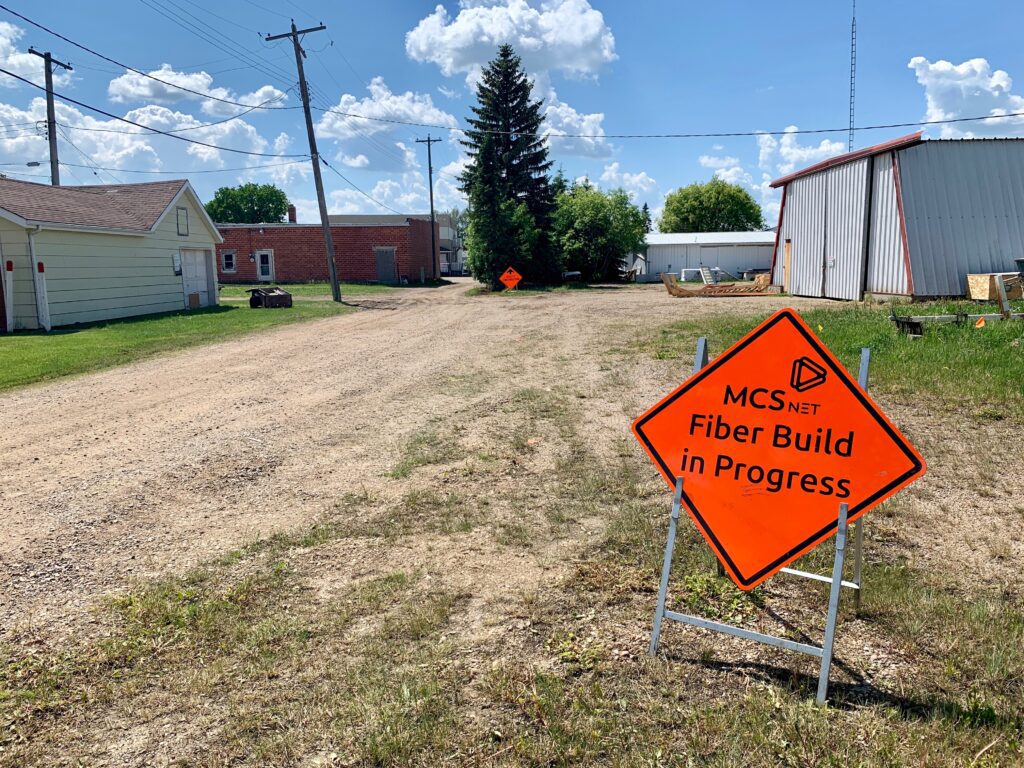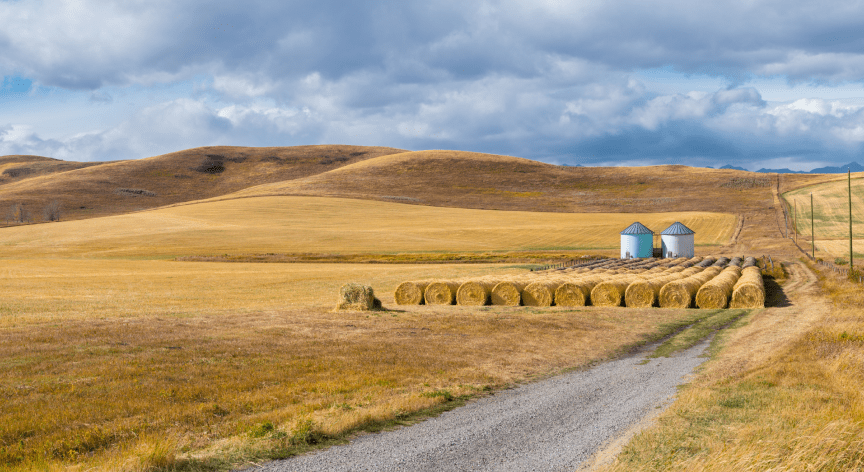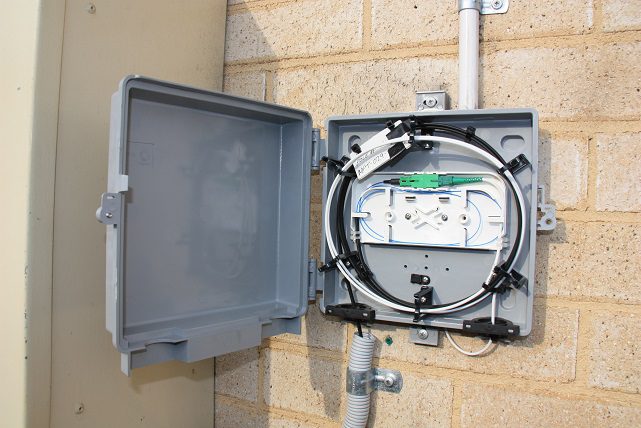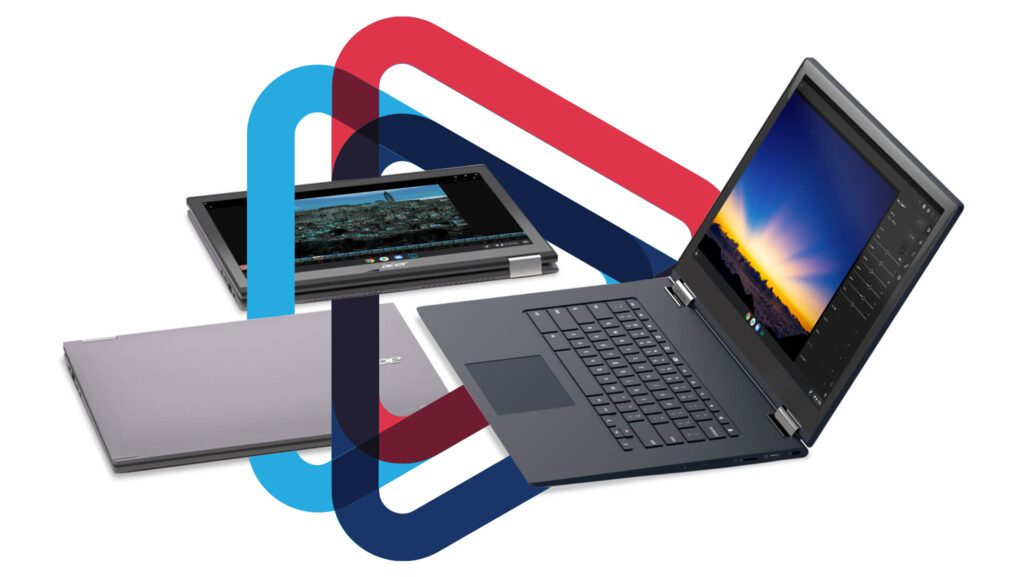
How Does Fiber Optic Internet Work?
Table of Contents
If you’re wondering what fiber has to do with the internet, you’re not the only one. It seems like we’re hearing a lot more about fiber optic these days than ever before — and for a good reason. With higher speeds, greater bandwidth, and better distance (just to name a few pros!), fiber is the future of internet in rural Alberta.
Fiber optic technology works by transmitting data in the form of a light signal through optical fibers, which are thinner than a human hair. These fibers are connected directly to your home or business, so you get our most reliable high-speed internet.
But as innovative as it is, Fiber optic comes with a unique set of challenges in the rural Alberta landscape. Fiber availability may be limited based on your location – installing the infrastructure can be challenging, especially in rough terrain. Also, because the technology is still in its infancy, it’s not widely available (yet!).
Understanding the ins and outs of fiber technology will not only help you determine if it’s right for you, but will also empower you to make the best decision when choosing a plan and an Internet Service Provider (ISP).
With this in mind, we’ve created this comprehensive guide to fiber optic internet: what it is, how it works, and where to find it in rural Alberta.
If you want to skip straight to our fiber optic internet plans, you can review them here.
Let’s get started!

Understanding Fiber Optic Internet Connection
What is fiber optic technology?
Fiber optic internet works by using pulsating light beams to send and receive data through fibre cables. These light beams zip through thin strands of glass or plastic at speeds about 20x faster than traditional cable internet connections. Because the data is in the form of light, the data literally travels at the speed of light, providing excellent performance.
If you’re deciding to switch from your current internet service to fiber optic, it might be helpful to illustrate the differences – let’s get into that next.
How does Fiber Optic compare?
DSL, cable, satellite, fiber optic – there are so many options, that it can be hard to compare them. In this section, we’ve stacked each type of internet up so you can see how they compare.
To illustrate the differences, imagine you’re trying to get from one point to another in rural Alberta; we’ll compare these internet types to different ways of travelling.
DSL: These days, DSL is like your grandmother’s dial-up internet. DSL uses your telephone line for internet, so there’s a significant amount of interference and lag. Think of DSL like a bicycle: it gets you from A to B, but it’s not ideal, especially in high traffic.
Cable: Cable internet is faster than DSL, but likely uses the same cables that bring you your TV signal. Think of Cable like a motorcycle. Faster than your bicycle, but uses the same roads during rush hour. This means if there’s a lot of traffic, it moves quite slowly.
Satellite: By relying on satellite dishes orbiting Earth, satellite users can get internet from (almost) any location. Think of satellite internet like a hot air balloon: it has a broad view and can reach places that DSL and cable can’t. It’s not the fastest method of transportation, and sometimes harsh weather can affect its journey. But it’s sometimes the only option, especially where the terrain is rough or mountainous.
Fiber Optic: Streamlined, efficient, and lightning-fast, fiber optic internet is like a bullet train. Travelling on tracks made of light, it can maintain high speeds without interruption and has no issue going long distances. Though building it is more expensive than the other options, fiber optic has the best speed, longevity, and durability of any internet option.
It might seem like fiber optic is the natural choice, but it isn’t one-size-fits-all. Next, we’ll discuss both the pros and cons of fiber optic so you can get the full picture.
Pros and Cons

Now that you are getting a clearer understanding of the benefits and limitations of fiber optic technology, it’s time to answer an important question: Is it worth it?
Is Fiber Optic Internet Worth It?
Time for the age-old tech question: to upgrade or not to upgrade? You know that fiber optic speed and bandwidth are unparalleled, but is it worth it? We’re going to break down whether fiber optic internet is truly worth the investment.
Durability
At face value, fiber optic internet can seem more expensive. The infrastructure demands, especially for new installations, can be high. However, when you break it down over the long run, it might be a different story.
- Longevity & Maintenance: Fiber cables degrade slower than traditional copper ones, meaning less maintenance. Over time, these savings can be significant.
- Efficiency: With fewer interruptions and outages, businesses can experience increased productivity. For home users, it means smoother streaming, better gaming, and a more seamless internet experience.
This might seem impressive on its own, but wait until you see fiber optic speeds – especially when compared to other internet service options.
Speed
You may be wondering: How much faster is fiber optic? Well, the numbers don’t lie!
DSL: Speeds can range from 1 Mbps to 1000 Mbps (1 Gbps).
Cable: Depending on your package and provider, speeds can be anywhere between 10 Mbps and 500 Mbps.
Satellite: Typically offers speeds between 12 Mbps and 100 Mbps, though weather conditions can impact speeds.
Fiber Optic: Are you ready for this? Entry-level fiber connections start at 250 Mbps, going up to 5 Gbps (5000 Mbps).
There is no competition when it comes to fiber optic speeds, but not everybody needs them. Let’s discuss whether or not switching is necessary based on your internet habits.
Is Switching Worth It?
For a casual user who checks emails and occasionally streams a show, a basic broadband connection might cut it. For those who need high speeds and use a lot of data (gamers, remote workers, families with multiple devices, heavy streamers), fiber is likely ideal for you. As we move into 4K and even 8K streaming in the coming years, fiber will soon become a necessity.
Fiber optic internet, with its speeds and reliability, certainly has an edge over other internet options. While the initial costs might be higher, the long-term benefits make it a compelling choice. As with all things, weigh your needs, budget, and future requirements to decide if it’s the right time to jump onto the fiber bandwagon.
How to Check Fiber Optic Internet Availability in Your Area
Is My Area Even Eligible?
You’re starting to think that upgrading to fiber optic might be worth it. Before you go any further down this path, it’s important to find out if fiber optic is offered in your area.
Installing fiber optic internet – particularly near mountains or tough terrain – is challenging. Due to this, very remote Albertans may not be eligible for fiber optic internet. Check with your ISP – most providers will have an Internet Coverage Map that can show you if you’re eligible.
If your area is eligible – congratulations! Now we move on to the next part: Is your house fiber-ready?
Is My House Fiber-Ready?
Being “fiber-ready” means that your home has the necessary infrastructure to connect to a fiber optic line. Look for a fiber distribution box (sometimes called an optical Network Terminal, or ONT) outside of your home. If you don’t see one, we can send a technician to come see if you are still eligible.
Once you’ve determined that your area and home are eligible for fiber optic, it’s time to select the right plan for you.
Choosing a Fiber Optic Internet Plan
There are a lot of things to consider when choosing an internet plan, including speed, data amount, and cost. We’ll walk you through the whole process so you can choose the best plan for your needs.
Step 1: Consider your Internet Usage
The first factor to look at when determining usage is the number of devices using data. A household of two will have different needs than a family of five. Of course, what you use your internet for matters as well, but we’ll go into that later.
Next, let’s dig into exactly what your household needs data for. Is there a heavy gamer in your house? Do you stream TV and movies frequently? Are you working from home? If you said yes to any of the above, you might need a plan with a larger data cap and higher speeds.
If you’re still lost, check out our blog post How Much Internet Do I Need?
Step 2: Determine Your Speed Need
- Basics (10-25 Mbps): Great for browsing, emails, and occasional streaming for one or two devices.
- Mid-range (50-100 Mbps): Suitable for HD streaming, online gaming, and moderate household use.
- High-end (100-1,000+ Mbps): Perfect for households with multiple devices, 4K streaming, gaming, and more.
Remember, with rural connectivity, it’s not just about raw speed but consistent speed. The stability fiber provides means that the speed you sign up for is the speed you’ll get – unlike other internet service plans, which display top speed, not average speed.
Step 3: Find Your Data Sweet Spot
Generally, ISPs offer both unlimited and limited data plans. The benefit of an unlimited plan is that you’d never worry about data caps or unpredictable bills every month from extra data fees. However, unlimited plans can be quite pricey.
If you opt for a limited data plan, make sure you understand your data cap terms. Ask your provider some key questions: Will you get an alert when you’re getting close to your cap? What are the extra data charges if you go over? Are there ways to cut down your data usage so you can prevent extra charges?
Step 4: Stick To Your Budget
Understand your budget and what you’re willing and able to pay for internet. If you can afford it, sometimes it’s better to pay a little bit more in cost for an amazing internet experience. It’s important to find the balance between getting the internet you need and paying what you can afford.
Step 5: Look for Excellent Customer Support
When selecting the right internet service provider, it’s important to know what to expect if you ever need assistance. Some nationwide providers will prioritize highly-populated urban areas for maintenance or repairs. This means rural customers can be left without service for extended periods.
Talk to the ISP, look up reviews from existing customers, and see what the process is like to get through to a person. Our advice: look for an Alberta-based provider so you can be sure you’re not in a queue with the rest of the country, especially if it’s urgent.
Tips on Finding the Best Plan:
- Word of Mouth: Talk to your neighbours and local businesses. Their experiences can provide invaluable insights.
- Promotions & Deals: Providers often have promotional deals, especially for new customers. However, be cautious and understand the terms. A great promotional rate might jump significantly after the initial period.
- Compare, Compare, Compare: Don’t settle for the first plan you come across. Make a spreadsheet to weigh the pros and cons of each offer. We have provided a quick comparison chart a little further down in this guide.
- Network Expansion: Even if a provider isn’t currently in your area, they might be expanding soon. Check their future coverage maps or contact them directly for information.
Remember: choosing the right fiber optic plan in rural Alberta isn’t just about getting the fastest speed for the lowest price. It’s about finding a plan that aligns with your needs, ensuring you have consistent and reliable access to the online world. If you want to check out our fiber optic plans, visit our website.
Installing Fiber Optic Cable Line
Fiber optic internet boasts superior reliability because it involves connecting fiber optic cables directly to your home. To do this, the installation process is complex. Without getting too technical, we’ll give you an idea of what to expect when you sign up for fiber optic.
The Fiber Optic Cable
A fiber optic cable looks like a thin strand of fishing line, no thicker than a strand of human hair, providing an excellent internet connection. It’s made of thin strands of pure glass which transmit data in the form of light signals.
If you want to get technical, there are several different types of fiber optic cables, but we won’t get too deep here. The main difference between fiber optic cable and regular cable? It is significantly more durable.
Durability
When installed and maintained correctly, fiber optic cables have an impressive lifespan: they can last up to 20-25 years. This is due to a couple of reasons. Firstly, the materials are more durable: the fibers are made of glass or plastic. Secondly, they’re buried about 30 inches underground, protecting them from harsh weather.
Because they need to be buried underground, the installation process can be time-consuming. Let’s get into that next.
The Installation
Step one to installing your new lightning-fast fiber Internet is to determine if your house has a fiber connection. Look for a Fiber Distribution Box (sometimes called an Optical Network Terminal, or ONT) on the outside of your home for a reliable internet connection.
Here is what a Fiber Distribution Box looks like:

If you don’t have this box on the outside of your home, we’ll send a technician to install one.
Next, we have to do a bit of digging: we’ll need to run a cable from the nearby fiber network centre to your property. Once the Fiber Distribution Box is hooked up to the network, it will link to your router through an Ethernet connection. This process can span several days.
After installation, we need to ensure that your new lightning-fast fiber optic data is ready to use. This brings us to the last thing we’ll discuss when it comes to setting up your fiber optic internet: your modem.
Replacing your Modem
Your modem is the bridge between the fiber optic network and your home Wi-Fi signal. It needs to turn the light signals of data into electronic signals (Wi-Fi) that your device can use. If you have Wi-Fi in your home currently, you already have a modem.
Will your current modem be able to do this? Generally, the answer is no. Traditional broadband modems don’t know how to convert fiber optic light beams into electronic signals. Fortunately, when you sign up for fiber optic, ISPs will often supply a compatible modem so you can connect seamlessly.
Installation Process From Start to Finish
Initial Consultation
We will send a technician to determine if your home is fiber-ready. If not, the tech will determine the best location for installation
Install Fiber Distribution Box
If your home isn’t fiber-ready, we will come and install the Optical Network Terminal (ONT) to the exterior of your home to connect to the fiber line.
Bringing fiber lines to your home
We come and lay the cables underground from the network data centre to your home by digging small trenches. This is the longest and most labour-intensive part of the installation.
Interior Setup
We will set up a modem and possibly a router, ensuring the light signals are converting properly and you’re ready to connect.
Testing
Before leaving, we’ll test all equipment to ensure your connection is strong, stable, and meets the promised speeds.
Now that you understand the installation process, it’s time to get into arguably the most important part of this process: choosing the right ISP.
Choosing a Fiber Optic Internet Provider
Comparing Fiber Optic Internet Providers
Choosing a provider can be a difficult decision. Moving forward with an ISP requires an understanding of offerings, support experience, and cost.
If you’re already with one of the major nationwide ISPs, you will find that they don’t offer fiber optic services in rural Alberta. This is likely because they won’t see a return on investment in lower-density areas. For this reason, the list is quite small.
Here is a breakdown of fiber options available in rural Alberta:

Tips on Choosing a Reliable Fiber Optic Provider
- Infrastructure Investment: A reliable provider will invest in their infrastructure. This is to ensure quality and reliability for users while future-proofing their equipment. (We put our money where our mouth is — since 2015, we’ve invested more than $20 million in our rural Alberta fiber optic network).
- Transparent pricing: A good way to know your provider is untrustworthy is to look for hidden fees. Look for sneaky costs in the terms and conditions like an activation fee, hardware fee, or even an installation fee that your provider isn’t transparent about.
- Local recommendations: Ask your neighbours if they have any recommendations! Keep in mind that fiber optic is a relatively new technology, so if they aren’t using fiber optic, focus on their experience with customer support.
- Customer service: If there’s an outage, you want to know that your provider will pick up the phone and deal with the issue quickly. Opt for a provider that truly values strong customer service. Look up reviews online (this is also where a word-of-mouth recommendation can come in handy!).
Before we wrap up this guide, we will talk briefly about the long-term forecast of fiber optic technology.
The Future of Fiber
These days, it sometimes feels like it’s impossible to keep up with technology. Every time you turn around there’s a new gold standard, a new device, a new way of doing things. According to recent research, the fiber optic market will grow annually by 8.5% by 2025 – which tells us that fiber optic technology is just going to get more popular in the coming years.
Fiber Optic vs. 5G
Ever since 5G emerged onto the scene, there’s been a lot of buzz about whether it will replace fiber optic internet. 5G is a great option for some, but as with all internet options, it’s not one-size-fits-all. Here’s a comparison of the two:
Speed & Reliability
5G promises high-speed data transmission, with numbers that rival fiber optic speeds. However, since 5G isn’t directly connected to your home, it will never be as reliable as fiber optic. This applies especially in rural Alberta, where the signal needs to travel long distances.
Infrastructure & Investment
Both fiber networks and 5G networks require a significant amount of infrastructure, which translates to long and expensive installation. However, 5G infrastructure may already exist in the form of towers and base stations already transmitting 4G. While regions with existing infrastructure might be eligible for 5G right away, more remote areas may have to wait.
Complementary, Not Competitive
We like to view 5G as another tool for connecting all Albertans, which is the whole reason we started this business in 1995! As we partner with the federal and provincial governments to bring high-speed internet to all Albertans, another network option brings us closer to that goal.
Conclusion
We hope that after reading this guide to fiber optic internet you have all the knowledge you need to make an informed choice. Through our explanations and examples, you should now understand the fiber optic difference, including speed, availability, cost, and installation.
Although we’ve tried to present as much information as we can, we hope you will do your research, using the knowledge from this article as a starting point. When it comes to selecting an internet provider, you want to make sure you understand what you’re getting yourself into, especially if you’re signing a multi-year contract.
And, of course, if we haven’t answered your questions, or you want to talk to someone directly, you can always contact us. Someone on our customer support team based in St. Paul is happy to help.
Have questions about fiber? We have answers
In rural Alberta, fiber plans generally start at around $59.99/mo and range up to around $99.99/mo. You might see cheaper fiber optic plans from nationwide providers, but don’t be fooled – these prices are for densely-populated urban areas, where providing fiber lines is cheap and simple. In rural areas, it is more labour- and cost-intensive to bring fiber optic to Albertans. However, we strive to make sure our plans are as affordable as possible, so our plans are still competitive with the big-city fiber plans.
Bringing fiber to rural Alberta is challenging for several reasons: mostly, our rugged Alberta terrain and harsh weather make installing miles of cable difficult. Additionally, running cable vast distances for fewer people is pricey, so most major providers don’t see the value. Despite these challenges, we are working hard to expand our fiber network across Alberta.
It depends! If you’re using your data for basic tasks – surfing the internet, some basic streaming, or listening to music – a download speed of 50 Mbps should be plenty. However, if your household uses multiple devices at once, or are into 4k streaming or heavy gaming, you will likely need a faster plan.
There are several reasons why your fiber internet may be lagging. This can be the result of poor-quality cables, a malfunctioning modem/router, or a plan that isn’t fast enough for your data usage, to name a few. If your fiber internet is slow, something may be wrong – give us a call and we’ll help you troubleshoot the issue!
No. Traditionally, broadband was delivered via phone lines, especially in the case of DSL. With fiber, the data is transmitted through light signals in dedicated cables, separate from the phone lines. However, always check with your provider about specific requirements.





